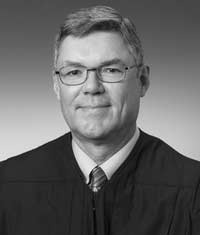
Chief Justice Joel Bolger will retire from Alaska’s Supreme Court on June 30 next year, creating yet another vacancy on Alaska’s highest court, which only has five members.

On Nov. 30 Bolger announced his plan to step down five years before reaching the mandatory retirement age of 70. He will be the second Supreme Court justice to depart the bench in two years. Two others reach retirement age in 2023 (Justice Daniel Winfree) and 2025 (Justice Peter Maassen).
As this turnover could transform the high court, the push to reform the judge selection process takes on new urgency. Conservatives have long criticized the closed-door manner in which judges are chosen in Alaska. The current system grants incredible power to the seven-member Alaska Judicial Council who vet all candidates and only send the ones they approve to the governor for his consideration.
Since the Judicial Council is always comprised of four members from the left-leaning Alaska Bar Association, and only three members appointed by the governor, conservative judges are almost always blocked during the vetting process. This means conservative governors are left to choose from among largely liberal candidates when filling vacant seats.
the AK Democratic platform opposes conventions because Alaskans may “strengthen the governor’s ability to make appointments.”
Judicial reform advocates have suggested several ways to improve this process so that it is not controlled by four unelected citizens. One idea entails expanding the Judicial Council to include more voting members appointed by the governor. Others have suggested using the time-tested system employed at the federal level in which the president nominates a candidate and the Senate holds confirmation hearings.
Changing Alaska’s system, however, requires a constitutional amendment, which must begin in the State Legislature.
Alaska’s Constitution can be amended the following ways:
- The Legislature can approve an amendment with a two-thirds vote in both the House and Senate. Then the amendment is put before voters at the next statewide general election. A simple majority of voters can approve it.
- The second option is through a constitutional convention, which Alaskans have an opportunity to hold in 2022. Every 10 years voters are asked whether the state shall hold a constitutional convention. If a majority votes in the affirmative, the 2022 convention would be an opportunity for delegates to suggest changes to the state constitution. Any changes would then need to be ratified by a majority of voters.
ALASKA WATCHMAN DIRECT TO YOUR INBOX
Given the current makeup of the Alaska Legislature, it’s highly unlikely it could marshal the two-thirds vote needed to put the convention question before Alaskans, especially since the 2020 Alaska Democratic Party platform explicitly opposes giving residents this option because they may propose “to elect the judiciary or strengthen the governor’s ability to make appointments.”
In 2022, however, Alaskans can decide for themselves. The last time this question came up was 2012 when 33% of Alaskans voted to hold a convention.
It’s not too early to begin discussing the benefits of giving voters a chance to reexamine the state constitution. It is a right of the people, enshrined in the Constitution, to address major problems. Judicial selection is as big as it gets.








3 Comments
GOOD doesn’t come soon enough………..!!!!
The path to a “yes” vote in ’22 on a convention begins with putting the PFD in the Constitution. Once a convention convenes, it can propose separate, distinct amendments on any subject it chooses. Alaska’s Constitution was written by a bunch of 1950’s liberals. The few conservatives there had no say. The lawyers got control of judicial selection. The teacher’s union got a ban on any public assistance to private education. A Second Alaska Convention could reflect the current political alignment, not one from over 60 years ago. This discussion should begin now.
A Constitutional Convention is the only way to restore the public part of the public process. The Judicial Branch is an island to itself. Its philosophy does not reflect a vast majority of what Alaskans hold dear. The Convention can solve the conflict between those who want to spend the Alaska Permanent Fund or pay it out of accountable earnings which the public can track. The desire of Alaskans to receive their investment earnings as agreed to many years ago can be a motivating call to arms to remove the Liberal biases so evident in Alaska’s government.